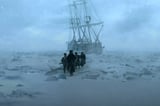DNA Unveils Franklin Expedition Leader's Fate: Captain Fitzjames Identified Among Cannibalism Evidence
September 24, 2024
The ill-fated Franklin expedition, which set sail in 1845 to find a navigable Northwest Passage, ended tragically with all 129 crew members presumed dead after their ships, HMS Erebus and HMS Terror, became trapped in ice.
Recent research has successfully identified Fitzjames's remains through DNA and genealogical evidence, matching a tooth found on King William Island to a descendant's cheek swab.
These findings shed new light on the tragic circumstances surrounding the expedition, emphasizing the importance of meticulous archaeological research.
This identification marks Fitzjames as the second of the 105 crew members to be positively identified, following the identification of engineer John Gregory in 2021.
Analysis of the remains revealed cut marks indicating that survivors, including Fitzjames, resorted to cannibalism during their desperate struggle for survival.
The researchers noted that while survival cannibalism is often viewed negatively, it can be understood in the context of the extreme desperation faced by the sailors.
Efforts to find descendants of Franklin expedition members have led to the discovery of Fitzjames's relatives, who expressed excitement upon learning about the identification.
Captain James Fitzjames, who served as second-in-command after Sir John Franklin's death, was one of the leaders of the expedition.
Doug Stenton, an archaeologist involved in the study, emphasized the importance of understanding the sailors' plight in the context of their actions during the expedition.
The wrecks of HMS Erebus and HMS Terror were discovered in 2014 and 2016, respectively, providing crucial context for understanding the fate of the expedition.
The research challenges sensationalized narratives about the expedition and highlights the significance of testimonies from Indigenous Inuit people, who first reported seeing survivors.
Fabiënne Tetteroo, a naval historian and fan of The Terror, played a crucial role in identifying Fitzjames's remains and is acknowledged in the research.
Summary based on 9 sources
Get a daily email with more Science stories
Sources

BBC News • Sep 24, 2024
DNA test helps identify sailor from doomed Arctic expedition
The Verge • Sep 25, 2024
A fan of AMC’s The Terror helped identify real-life crew member of doomed expedition
ScienceDaily • Sep 24, 2024
Another Franklin expedition crew member has been identified
New Scientist • Sep 25, 2024
We now know who was cannibalised on the doomed Franklin expedition